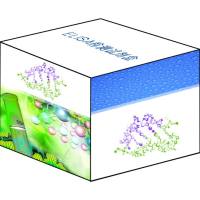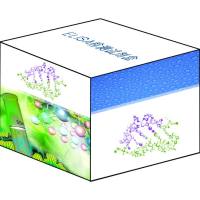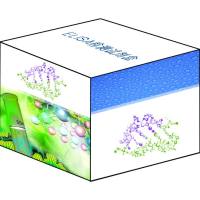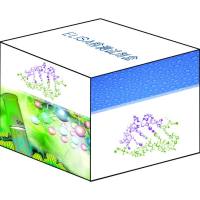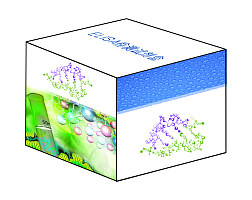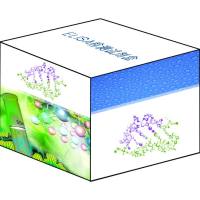
产品详情
文献和实验
相关推荐
样本 :液体
标记物 :通用型
适应物种 :不限
应用 :科研单位
检测方法 :荧光PCR
检测限 :不限
库存 :可定制
供应商 :上海瓦兰生物
规格 :25t/50t
猪流感病毒(通用型)核酸荧光PCR检测试剂盒
【产品名称】
通用名称:猪圆环病毒II型检测试剂盒(实时荧光PCR法)
英文名称:Porcine Circovirus II Detection Kit (Real-Time PCR Method)
【包装规格】 25 T/盒 & 50 T/盒
【预期用途】
猪圆环病毒(porcine circovirus,PCV)在分类学上属圆环病毒科圆环病毒属,为已知的最小的动物病毒之一。本试剂盒利用实时荧光PCR原理,定性检测PCV II型,对PCV II型引起的猪的疫病的诊断和监控具有重要指导意义。
【检验原理】
本试剂盒针对PCVII型基因组高度保守区域设计特异性引物和探针,在反应体系中含PCVII型基因组模板的情况下,PCR反应得以进行并释放荧光信号。利用仪器对PCR过程中相应通道的信号强度进行实时监测和输出,实现检测结果的定性分析。
【主要组成成份】
注:阴性对照为猪基因组DNA,阳性对照为PCV II经灭活处理的核酸提取物。
【储存条件及有效期】避光-20℃以下保存,避免反复冻融,有效期12个月。
【适用仪器】ABI 系列、Bio-Rad系列、Agilent Stratagene MX系列、Roche LightCycler R480、Cepheid SmartCycler、Rotor-Gene系列、杭州博日系列等多通道实时荧光定量PCR仪。
【样本要求】
1. 新鲜采集的咽拭子、鼻拭子和粪便标本,并使用灭菌生理盐水悬浮。
2. 标本收集后若不能立即检测,可置于2~8℃冷藏过夜保存;如需长期保存,标本应冻存于-20℃~-80℃。
3. 标本保存期间应避免反复冻融。
【检验方法】
(2)核算当次实验所需要的反应数(n),并根据如下表所示反应体系计算当次实验所需要的各种试剂量。
n =阴性对照数(1T)+阳性对照数(1T)+误差预留量(1T)+样本数
(3)在无菌离心管中加入上述试剂,充分混匀后瞬时离心。按照20 μL/管分装量将试剂分装至PCR反应管。
(4)盖紧PCR反应管盖后将PCR反应管和试剂盒中的DNA提取液转移至样本处理区。剩余试剂放回-20℃以下冰箱冷冻保存。
2.样本准备(样本处理区)
用QIAGEN、Roche公司DNA提取试剂盒提取DNA,具体操作按照其试剂盒说明书操作。
3.加样
在上述制备好的PCR反应样本管中分别加入处理好的待测标本DNA各5 μl、终体积25 μl/管,盖好PCR反应盖混匀后瞬时低速离心,转移到PCR仪器上。阴性对照和阳性对照管则各加5 μL试剂盒自带的阴性对照或阳性对照品,终体积为25 μl/管,盖好PCR反应盖混匀后瞬时低速离心,转移到PCR仪器上。
4.PCR(PCR扩增区)
(1)取样本处理区准备好的PCR反应管,放置在实时荧光定量PCR仪样品槽相应位置,并记录放置顺序。
(2)按下表设置仪器核酸扩增相关参数进行PCR扩增。
【产品名称】
通用名称:猪圆环病毒II型检测试剂盒(实时荧光PCR法)
英文名称:Porcine Circovirus II Detection Kit (Real-Time PCR Method)
【包装规格】 25 T/盒 & 50 T/盒
【预期用途】
猪圆环病毒(porcine circovirus,PCV)在分类学上属圆环病毒科圆环病毒属,为已知的最小的动物病毒之一。本试剂盒利用实时荧光PCR原理,定性检测PCV II型,对PCV II型引起的猪的疫病的诊断和监控具有重要指导意义。
【检验原理】
本试剂盒针对PCVII型基因组高度保守区域设计特异性引物和探针,在反应体系中含PCVII型基因组模板的情况下,PCR反应得以进行并释放荧光信号。利用仪器对PCR过程中相应通道的信号强度进行实时监测和输出,实现检测结果的定性分析。
【主要组成成份】
| 序号 | 组成 | 25 T/盒 | 50 T/盒 |
| 1 | PCV II PCR反应液 | 437.5 μL×1管 | 875 μL×1管 |
| 2 | PCV II 混合酶液 | 62.5 μL×1管 | 125 μL×1管 |
| 3 | PCV II 阳性对照 | 40 μL×1管 | 40 μL×1管 |
| 4 | PCV II 阴性对照 | 40 μL×1管 | 40 μL×1管 |
| 5 | 说明书 | 1份 | 1份 |
【储存条件及有效期】避光-20℃以下保存,避免反复冻融,有效期12个月。
【适用仪器】ABI 系列、Bio-Rad系列、Agilent Stratagene MX系列、Roche LightCycler R480、Cepheid SmartCycler、Rotor-Gene系列、杭州博日系列等多通道实时荧光定量PCR仪。
【样本要求】
1. 新鲜采集的咽拭子、鼻拭子和粪便标本,并使用灭菌生理盐水悬浮。
2. 标本收集后若不能立即检测,可置于2~8℃冷藏过夜保存;如需长期保存,标本应冻存于-20℃~-80℃。
3. 标本保存期间应避免反复冻融。
【检验方法】
- 试剂准备(试剂准备区)
(2)核算当次实验所需要的反应数(n),并根据如下表所示反应体系计算当次实验所需要的各种试剂量。
n =阴性对照数(1T)+阳性对照数(1T)+误差预留量(1T)+样本数
| 单反液配制表(每份) | PCR反应液 | 17.5 μL |
| 混合酶液(Taq酶+UNG酶) | 2.5 μL |
(4)盖紧PCR反应管盖后将PCR反应管和试剂盒中的DNA提取液转移至样本处理区。剩余试剂放回-20℃以下冰箱冷冻保存。
2.样本准备(样本处理区)
用QIAGEN、Roche公司DNA提取试剂盒提取DNA,具体操作按照其试剂盒说明书操作。
3.加样
在上述制备好的PCR反应样本管中分别加入处理好的待测标本DNA各5 μl、终体积25 μl/管,盖好PCR反应盖混匀后瞬时低速离心,转移到PCR仪器上。阴性对照和阳性对照管则各加5 μL试剂盒自带的阴性对照或阳性对照品,终体积为25 μl/管,盖好PCR反应盖混匀后瞬时低速离心,转移到PCR仪器上。
4.PCR(PCR扩增区)
(1)取样本处理区准备好的PCR反应管,放置在实时荧光定量PCR仪样品槽相应位置,并记录放置顺序。
(2)按下表设置仪器核酸扩增相关参数进行PCR扩增。
| 反应体积 | 25 μL | 通道选择 | FAM通道采集PCV II 荧光信号 |
| PCR 反应 条件 |
步骤 | 条件 | 循环数 |
| UNG处理 | 50℃:2分钟(min) | 1 | |
| 预变性 | 95℃:3分钟(min) | 1 | |
| 预扩增 | 95℃:5秒(s) | 5 | |
| 55℃:40秒(s) | |||
| PCR扩增 | 95℃:5秒(s) | 40 | |
| 55℃:40秒(s) (此阶段结束时采集荧光信号) |
【参考值(参考范围)】
1.试剂盒有效性判定:
(1)阳性对照:有典型S型扩增曲线或Ct值≤35。
(2)阴性对照:Ct值>38或无Ct值,线形为直线或轻微斜线,无指数增长期。
2.标本结果判定:
(1)阳性:标本检测结果Ct值≤35或有明显指数增长期。
(2)可疑:标本检测结果Ct值在35~38范围内。此时应对标本进行重复检测,如重复实验结果Ct值仍在35~38范围内,有明显指数增长期,则判定为阳性,否则为阴性。
(3)阴性:标本检测结果Ct值>38或无Ct值。
【检验结果的解释】
| 通道及检测结果 | 标本检测结果解释 |
| FAM | |
| 阴性(-) | 标本中未检出PCV II |
| 阳性(+) | 标本中检测出PCV II |
- 当检测样本中被检核酸浓度含量低于本试剂盒的最低检出限时可能会发生假阴性的结果。
- 本试剂盒仅供标本初步筛查使用,对于本试剂盒检测阳性结果应进一步使用培养法进行确诊。
【注意事项】
- 整个检测过程应严格按照本说明书要求分别在试剂准备区、样本处理区和PCR扩增区进行操作,各区实验服、仪器、耗材应独立使用,不能混用;实验用吸头采用带滤芯吸头;样本处理区应配有生物安全柜,样本处理在生物安全柜中进行操作;三个区应该配有紫外线杀菌装置。
- 每次实验应该设置阴、阳性对照。
- 为保证试剂不受标本污染,必须将DNA提取液、混合酶液及PCR反应液保存于试剂准备区。
- 试剂盒所有试剂在使用前应该在常温下充分融化混匀,并应瞬时离心。
- 试剂盒内所配阴性和阳性对照在第一次使用前应全部转移至标本准备区,并单独存放。
- 为防止荧光干扰,应避免裸手直接接触PCR反应管,并应避免在PCR反应管上进行任何标记。
- 仪器扩增相关参数应按照本说明书相关要求进行设置;不同批号试剂不能混用。
- ABI系列荧光定量PCR仪参数设置中不选ROX校正,淬灭基因选择None。
- 实验过程中产品的废弃物应该进行无害化处理后方可丢弃。
Sample collection and storages
Serum - Use a serum separator tube and allow samples to clot for 30 minutes before centrifugation for 10 minutes at approximately 3000×g. Remove serum and assay immediately or aliquot and store samples at -20℃ or -80℃.Avoid repeated freeze-thaw cycles
Plasma - Collect plasma using EDTA or heparin as an anticoagulant. Centrifuge samples for 30 minutes at 3000×g at 2-8℃ within 30 minutes of collection. Store samples at -20℃or -80℃. Avoid repeated freeze-thaw cycles.
Cell culture supernates and other biological fluids - Remove particulates by centrifugation and assay immediately or aliquot and store samples at -20℃or -80℃. Avoid repeated freeze-thaw cycles.
Note: The samples should be centrifugated adequately and no hemolysis or granule was allowed.
Materials required but not supplied
1. Standard microplate reader(450nm)
2. Precision pipettes and Disposable pipette tips.
3. 37 ℃ incubator
Precautions
1. Do not substitute reagents from one kit to another. Standard, conjugate and microplates are matched for optimal performance. Use only the reagents supplied by manufacturer.
2. Do not remove microplate from the storage bag until needed. Unused strips should be stored at 2-8°C in their pouch with the desiccant provided.
3. Mix all reagents before using.
Remove all kit reagents from refrigerator and allow them to reach room temperature ( 20-25°C)
Materials supplied
Note: Standard concentration was followed by:
8、4、2、1、0.5、0 ng/ml.
Reagent preparation
20×wash solution:Dilute with Distilled or deionized water 1:20.
Assay procedure
1. Prepare all reagents before starting assay procedure. It is recommended that all Standards and Samples be added in duplicate to the Microelisa Stripplate.
2. Add standard: Set Standard wells, testing sample wells. Add standard 50μl to standard well.
3. Add Sample: Add testing sample 10μl Then add sample diluent 40μl to testing sample well; Blank well doesn’t add anyting.
4. Add 100μl of HRP-conjugate reagent to each well, cover with an adhesive strip and incubate for 60 minutes at 37°C.
5. Aspirate each well and wash, repeating the process four times for a total of five washes. Wash by filling each well with Wash Solution (400μl) using a squirt bottle, manifold dispenser or autowasher. Complete removal of liquid at each step is essential to good performance. After the last wash, remove any remaining Wash Solution by aspirating or decanting. Invert the plate and blot it against clean paper towels.
6. Add chromogen solution A 50μl and chromogen solution B 50μl to each well. Gently mix and incubate for 15 minutes at 37°C. Protect from light.
7. Add 50μl Stop Solution to each well. The color in the wells should change from blue to yellow. If the color in the wells is green or the color change does not
Serum - Use a serum separator tube and allow samples to clot for 30 minutes before centrifugation for 10 minutes at approximately 3000×g. Remove serum and assay immediately or aliquot and store samples at -20℃ or -80℃.Avoid repeated freeze-thaw cycles
Plasma - Collect plasma using EDTA or heparin as an anticoagulant. Centrifuge samples for 30 minutes at 3000×g at 2-8℃ within 30 minutes of collection. Store samples at -20℃or -80℃. Avoid repeated freeze-thaw cycles.
Cell culture supernates and other biological fluids - Remove particulates by centrifugation and assay immediately or aliquot and store samples at -20℃or -80℃. Avoid repeated freeze-thaw cycles.
Note: The samples should be centrifugated adequately and no hemolysis or granule was allowed.
Materials required but not supplied
1. Standard microplate reader(450nm)
2. Precision pipettes and Disposable pipette tips.
3. 37 ℃ incubator
Precautions
1. Do not substitute reagents from one kit to another. Standard, conjugate and microplates are matched for optimal performance. Use only the reagents supplied by manufacturer.
2. Do not remove microplate from the storage bag until needed. Unused strips should be stored at 2-8°C in their pouch with the desiccant provided.
3. Mix all reagents before using.
Remove all kit reagents from refrigerator and allow them to reach room temperature ( 20-25°C)
Materials supplied
| Name | 96 determinations | 48 determinations |
| Microelisa stripplate | 12*8strips | 12*4strips |
| Standard | 0.3ml | 0.3ml |
| Sample diluent | 6.0ml | 3.0ml |
| HRP-Conjugate reagent | 10.0ml | 5.0ml |
| 20X Wash solution | 25ml | 15ml |
| Chromogen Solution A | 6.0ml | 3.0ml |
| Chromogen Solution B | 6.0ml | 3.0ml |
| Stop Solution | 6.0ml | 3.0ml |
| Closure plate membrane | 2 | 2 |
| User manual | 1 | 1 |
| Sealed bags | 1 | 1 |
8、4、2、1、0.5、0 ng/ml.
Reagent preparation
20×wash solution:Dilute with Distilled or deionized water 1:20.
Assay procedure
1. Prepare all reagents before starting assay procedure. It is recommended that all Standards and Samples be added in duplicate to the Microelisa Stripplate.
2. Add standard: Set Standard wells, testing sample wells. Add standard 50μl to standard well.
3. Add Sample: Add testing sample 10μl Then add sample diluent 40μl to testing sample well; Blank well doesn’t add anyting.
4. Add 100μl of HRP-conjugate reagent to each well, cover with an adhesive strip and incubate for 60 minutes at 37°C.
5. Aspirate each well and wash, repeating the process four times for a total of five washes. Wash by filling each well with Wash Solution (400μl) using a squirt bottle, manifold dispenser or autowasher. Complete removal of liquid at each step is essential to good performance. After the last wash, remove any remaining Wash Solution by aspirating or decanting. Invert the plate and blot it against clean paper towels.
6. Add chromogen solution A 50μl and chromogen solution B 50μl to each well. Gently mix and incubate for 15 minutes at 37°C. Protect from light.
7. Add 50μl Stop Solution to each well. The color in the wells should change from blue to yellow. If the color in the wells is green or the color change does not
appear uniform, gently tap the plate to ensure thorough mixing.
8. Read the Optical Density (O.D.) at 450 nm using a microtiter plate reader within 15 minutes.
Calculation of results
- This standard curve is used to determine the amount in an unknown sample. The standard curve is generated by plotting the average O.D. (450 nm) obtained for each of the six standard concentrations on the vertical (Y) axis versus the corresponding concentration on the horizontal (X) axis.
- First, calculate the mean O.D. value for each standard and sample. All O.D. values, are subtracted by the mean value of the zero standard before result interpretation. Construct the standard curve using graph paper or statistical software.
- To determine the amount in each sample, first locate the O.D. value on the Y-axis and extend a horizontal line to the standard curve. At the point of intersection, draw a vertical line to the X-axis and read the corresponding concentration.
- Any variation in operator, pipetting and washing technique, incubation time or temperature, and kit age can cause variation in result. Each user should obtain their own standard curve.
- The sensitivity by this assay is 0.1 ng/ml.
- Standard curve
Storage: 2-8℃.
validity: six months.
FOR RESEARCH USE ONLY; NOT FOR THERAPEUTIC OR DIAGNOSTIC APPLICATIONS! PLEASE READ THROUGH ENTIRE PROCEDURE BEFORE BEGINNING!

上海瓦兰生物科技有限公司
实名认证
金牌会员
入驻年限:11年





